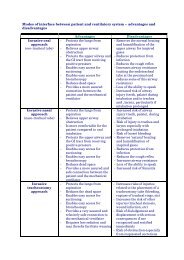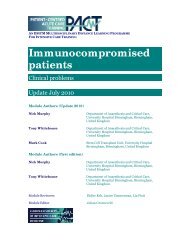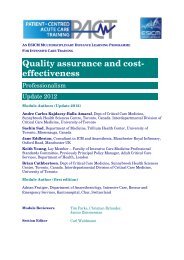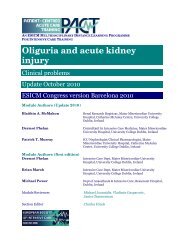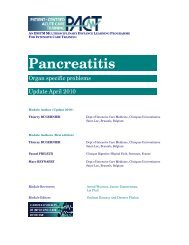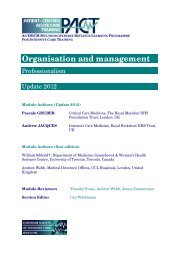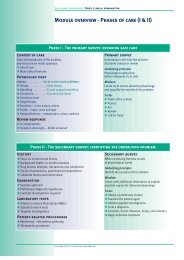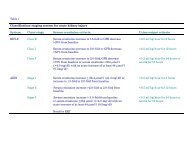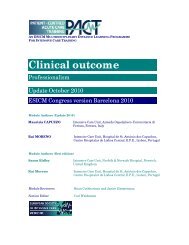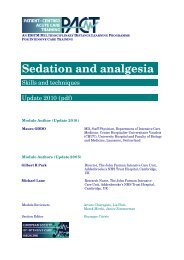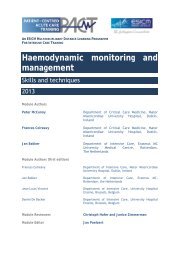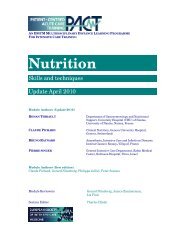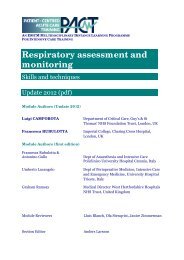Burns injury - PACT - ESICM
Burns injury - PACT - ESICM
Burns injury - PACT - ESICM
Create successful ePaper yourself
Turn your PDF publications into a flip-book with our unique Google optimized e-Paper software.
(VAP) prolonging ventilator therapy. When the <strong>injury</strong> involves the lower part of the<br />
body, try to avoid intubation except during necrosectomy and grafting. Dressings can<br />
be performed under ketamine anaesthesia under spontaneous ventilation. If<br />
intubation is needed for procedual purposes; the anaesthesiologist is usually willing<br />
to extubate after finishing the procedure.<br />
Rocourt DV, Hall M, Kenney BD, Fabia R, Groner JI, Besner GE. Respiratory<br />
failure after pediatric scald <strong>injury</strong>. J Pediatr Surg 2011; 46(9): 1753–<br />
1758. PMID 21929985<br />
Circulation<br />
Delayed venous access and a late start with volume resuscitation increases mortality.<br />
If venous access is difficult, an intraosseous access is a good alternative in the acute<br />
phase. An indwelling urinary catheter is mandatory in the resuscitation phase in<br />
children with <strong>injury</strong> >12-15 %TBSA. Aim for a urinary output of 1 mL/kg/hr in children<br />
and 2 mL/kg/hr in infants. Be aware that children have a major ability for<br />
physiological compensation, and hypovolaemia is often not recognised before >25% of<br />
circulating volume is lost. To diagnose hypovolaemia in a child, one should assess<br />
mental status, pulse pressure, arterial blood gases (low base excess), increasing<br />
lactate and colour /temperature of the extremities.<br />
A child with clammy, cool extremities but with normal blood pressure and<br />
heart rate is a child in danger.<br />
Surface area and fluid resuscitation<br />
Small size makes children challenging for physicians and nurses, who are often more<br />
used to working with adults. It is important to recognise that fluid losses are<br />
proportionally larger in children than in adults due to a large surface area compared<br />
to fluid weight. The rule of nine does not apply to children less than 15 years of age,<br />
and the Lund and Browder chart should be used to calculate burned surface area.<br />
Venous access may be particularly difficult in pre-hospital settings; intraosseous<br />
access is particularly well suited.<br />
To calculate body surface, one can use a simple nomogram or a formula [interactive<br />
version].<br />
The Parkland formula is unsuitable for children less than 30 kg BW but a modified<br />
version is shown below. The most common formula used for fluid resuscitation in<br />
children is based on surface area:<br />
5000 mL/m 2 %TBSA burned (due to the <strong>injury</strong>) + 2000 mL/m 2 TBSA (maintenance<br />
fluid).<br />
This formula favours over-resuscitation which is a risk in children as much as in<br />
adults. The maintenance fluid should probably be reduced (as outlined in the adult<br />
section) but there is not specific, strong evidence on this point.<br />
42



